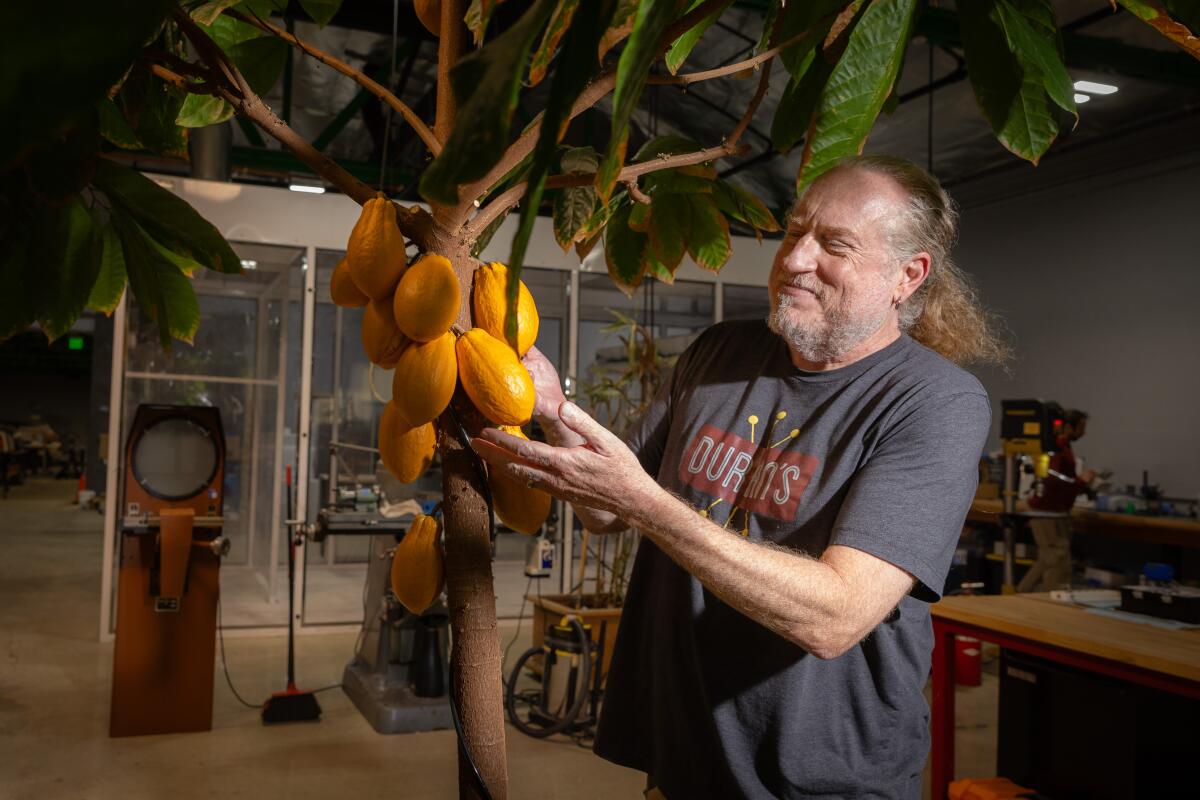What beachgoers need to know about poisoned sea lions

- Share via
Good morning. Here’s what you need to know to start your day.
- There’s a surge in sickened and stranded marine mammals. Here is what you need to know.
- An O.C. couple’s sudden deportation sends shock waves: ‘They have never broken the law.’
- At some L.A. restaurants, table bread is the main attraction.
- And here’s today’s e-newspaper.
Los Angeles County’s sea lions are struggling right now
For about a month, a poisoning event has continued to surge along the coast, sickening hundreds of the beloved marine mammals. Roughly 140 have been taken to the Marine Mammal Care Center in San Pedro.
The culprit: a deadly neurotoxin called domoic acid, which is produced by algal blooms in coastal waters. Filter-feeding fish, including anchovies and sardines, ingest the algae, retain its toxic byproduct and are then eaten by sea lions, seals and dolphins.
“Ingesting domoic acid from harmful algal blooms can cause sea lions to have seizures or to crane their heads in a motion known as ‘stargazing,’” Times reporter Summer Lin wrote this week. “They can also fall into a comatose state.”

It’s unknown how many sea lions have died during this bloom since it’s still ongoing. But a similar poisoning event in 2023 resulted in the deaths of more than 1,000 sea lions, Summer noted.
The 2023 crisis was the “worst domoic acid bloom in recorded history in Southern California,” according to John Warner, chief executive of the Marine Mammal Care Center. The current bloom could change that, he told Summer, as the center has taken in more sea lions than in 2023 — and more males in particular, which are larger and tougher to take down.
“We’re taking them in without them putting up a fight,” he said. “That says a lot about the condition that they’re in.”
“Sea lions have a 50% to 65% survival rate when they’re taken in for treatment in a timely manner,” Summer explained. At least 50 dolphins have been found poisoned and stranded on beaches, though domoic acid ingestion is typically a death sentence for them.
The center is nearing capacity, causing concern that if the bloom continues, sickened animals will have to be left on the beach.

Human-caused climate change is part of the problem, experts say
Toxic algal blooms are becoming more common, intense and widespread due in part to our planet-warming activities, according to scientists.
The combination of increasing ocean temperatures and acidification due to nitrate runoff have worsened toxic algal events, Warner told Summer. The recent storms in L.A. County played a key role, sending organic runoff into the Pacific and feeding the algae.
“Large domoic acid blooms usually happen every three to seven years,” Summer reported, “but Warner said that scientists expect to see these events happen much more frequently.”

What should you do if you encounter a sick marine mammal?
First and foremost, keep your distance. Stay at least 50 feet from sick or stranded marine mammals — and fight off any urge to take a selfie with them.
They can aggressively lunge or bite without warning, experts note.
Warner warned beachgoers to avoid crowding around a beached dolphin or attempting to move it back into the water. Dolphins get distressed by being close to humans and can suffer heart attacks.
If you encounter a sick or stranded marine mammal in L.A. County, call the Marine Mammal Care Center at (800) 399-4253. The National Oceanic and Atmospheric Administration has a contact list for the rest of California and the West Coast.
Today’s top stories
An O.C. couple’s sudden deportation sends shock waves
- Nelson and Gladys Gonzalez lived in the U.S. illegally for decades, working hard and raising a family while regularly checking in with ICE as part of an agreement to remain in the country.
- But when the Laguna Niguel couple showed up for a routine check-in on Feb. 21, they were detained and sent back to Colombia.
- Advocates say the case is part of a troubling trend: immigrants living in the country without legal authorization, who have no criminal history, being detained during routine check-ins and in some cases deported.
The Pasadena Unified School District files a lawsuit against Edison over Eaton fire damages
- The district is seeking compensation for the loss of multiple buildings that burned in the Eaton fire and the ensuing disruption of its operations.
- The lawsuit alleges the utility failed to temporarily shut down power lines in Eaton Canyon despite ample warnings of a strong windstorm from the National Weather Service amid abundant dry vegetation near its power lines.
What else is going on
- A magnetic pouch is key to enforcing school cellphone bans. Kids are getting around it.
- Barbara Lee has avid fans in the Oakland mayor’s race. But Loren Taylor is making it a contest.
- Yosemite National Park summer reservations have reopened after delays.
- Trump wants to rein in federal judges. One California Republican is already working on it.
- 23andMe shares tumble after bankruptcy filing and California attorney general’s privacy warning.
- As Conan O’Brien receives the Mark Twain humor prize at the Kennedy Center, the joke is on Trump.
- Trump officials share war plans in a group chat that included a journalist.
- Trump called Tiger Woods a ‘true legend.’ Now the golfer is dating Vanessa Trump, the president’s ex-daughter-in-law.
- ‘No Other Land’ filmmaker Hamdan Ballal was detained by Israeli forces after he was allegedly attacked by settlers.
Get unlimited access to the Los Angeles Times. Subscribe here.
Commentary and opinions
- Near death, Pope Francis rallied back. We need his voice more than ever, columnist Gustavo Arellano writes.
- Social Security needs protection from Trump, as the disastrous acting commissioner shows, columnist Michael Hiltzik writes.
- JuJu Watkins’ knee injury cuts deep into the USC star and Trojans’ title hopes, writes columnist Bill Plaschke.
This morning’s must reads

Voice clones pose an ‘existential crisis’ for actors: ‘It’s a violation of our humanity.’ Nearly a dozen actors interviewed by The Times said they are fearful of what their voices could be used for if they’re cloned without their knowledge. Whether that content is a violation of exclusivity clauses they signed with existing clients or something they morally disagree with, voice cloning could hurt more than just their wallets.
Other must reads
- Even 20 years after ‘The Office’ premiere, Jim and Pam still make us swoon.
How can we make this newsletter more useful? Send comments to essentialcalifornia@latimes.com.
For your downtime
Going out
- 🍞At some L.A. restaurants, table bread is the main attraction.
- 🍻26 bars and restaurants near Dodger Stadium for before or after a game.
Staying in
- 📺‘The White Lotus’ Season 3, Episode 6 recap: Another blue-hued Ratfliff nightmare sets in motion an episode that delves into worst-case scenarios for some of the show’s characters.
- 🦀 Here’s a recipe for a spring crab sandwich.
- ✏️ Get our free daily crossword puzzle, sudoku, word search and arcade games.
A question for you: What’s your favorite April Fool’s Day joke?
April Fool’s Day is a week away and we want to hear from you.
Email us at essentialcalifornia@latimes.com, and your response might appear in the newsletter this week.
And finally ... your photo of the day
Show us your favorite place in California! Send us photos you have taken of spots in California that are special — natural or human-made — and tell us why they’re important to you.

Today’s great photo is from Times photographer Jason Armond inside the San Gabriel lab of the “father” of the Xbox who is now perfecting lab-grown chocolate.
Have a great day, from the Essential California team
Ryan Fonseca, reporter
Defne Karabatur, fellow
Andrew Campa, Sunday reporter
Kevinisha Walker, multiplatform editor
Hunter Clauss, multiplatform editor
Christian Orozco, assistant editor
Stephanie Chavez, deputy metro editor
Karim Doumar, head of newsletters
Check our top stories, topics and the latest articles on latimes.com.






